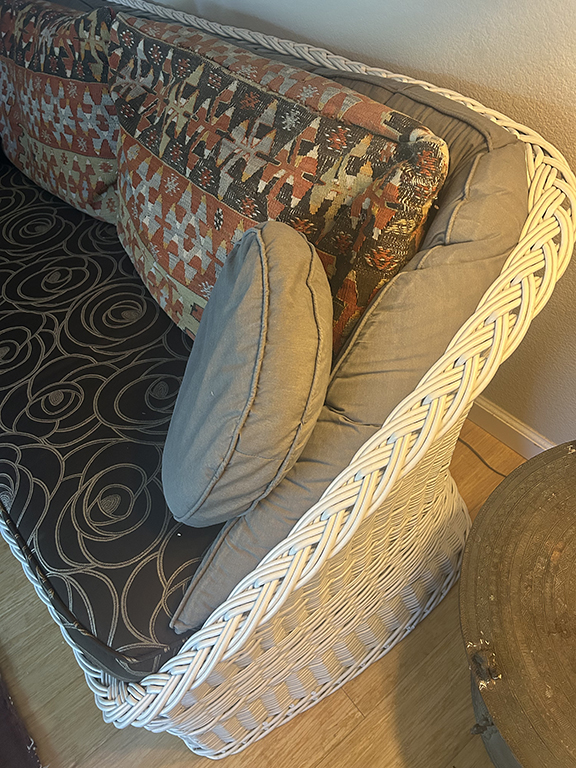
I first sat on my wicker sofa in diapers as a toddler, 75 years ago. It was located on our screened-in porch on the western side of our house in the suburbs of New York. Given summer’s mosquitos, a screened-in porch was not not a luxury, but a necessity.
The sofa spent many years in my mother’s apartment in Manhattan, and the two of us would sit on it when I’d visit her and sit in the little windowed patio overlooking Central Park. After she died, I had it moved here to Sonoma where it provided seating in our sunroom. Now the wicker sofa is in my condo, and I sit on it when I put on my socks or watch TV.
The sofa is one of a number of possessions once owned by other members of my family. They fill my home, alongside artworks, curios, dishes, silverware, and other pieces of furniture passed down to me, including a complete set of formal chinaware that used to belong to my late wife Norma’s grandmother. I’m surrounded by objects of the dead, items that were included in past lives, some of them 500 or more years old. I even have a Trilobite fossil I bought for $4 that’s been around for millions of years.
Most of my other possessions, some quite old, used to belong to someone else as well, although who they were I do not know. In some unpredictable way, they have made their way into my hands. Many show their age, having moved literally across the globe to end up together in my condo. So it is that a heavy acrylic globe that my father bought in 1975 filled with flecks of gold leaf and other refractive surfaces sits atop a three-footed stool from Africa, not far from a 200-year-old Japanese spittoon I bought for my wife forty-five years ago. What was the probability of that happening?
When each object was created, it began a trajectory into the future, but the odds of a Gold-leafed cow’s head from Burma ending up on the wall next to an Oxen mask from Burundi in Africa are incalculably small. Then again, probability is like that. The probability of conception for each of us, for example, is one in trillions and yet, here we are, defying the odds. Enduring alongside other objects of existence makes enjoying their company and giving them attention understandable; we are conjoined within the same timeline, at least for a while.
Time is a mystery, and remains not fully understood. Its companion, space, is equally mysterious. Current theories include quantum holography, that what we experience as four-dimensional time and space are co-emergent properties of a deeper underlying structure we cannot perceive. It’s no wonder we take comfort in latching on to objects of meaning and carrying them with us for a while. It feels good to have company.
All these separate objects, as evanescent as they are, us included, are moving through spacetime, from our perspective. They often provide comfort and meaning to our lives, each as treasured as a diamond or gold even though they may have originally been bought at Woolworth’s in 1928 for $1.59. Endurance alone imparts human value, a token of the continuity of existence.
Speaking of continuity, another scientific theory now posits that when it comes to the universe, there is no beginning and will be no end, and if true, that includes us. What’s the probability of that?
Oh Larry, I just love your My Wicker Sofa piece. I totally relate. Thank you for writing this.
The universe might just be one of many. All or some of them situated on a torus. I say this having eaten my first donut in years yesterday. It was fresh from the fat and delicious. I hope you’re happy and healthy on you wicker sofa. 💕
No basement. No ceiling. In space you can go smaller or bigger for ever. And further into the past and deeper into the future. That seems true to me – natural the basic fact of mystery. But of course this is disputed – perhaps by those who cannot tolerate mystery.